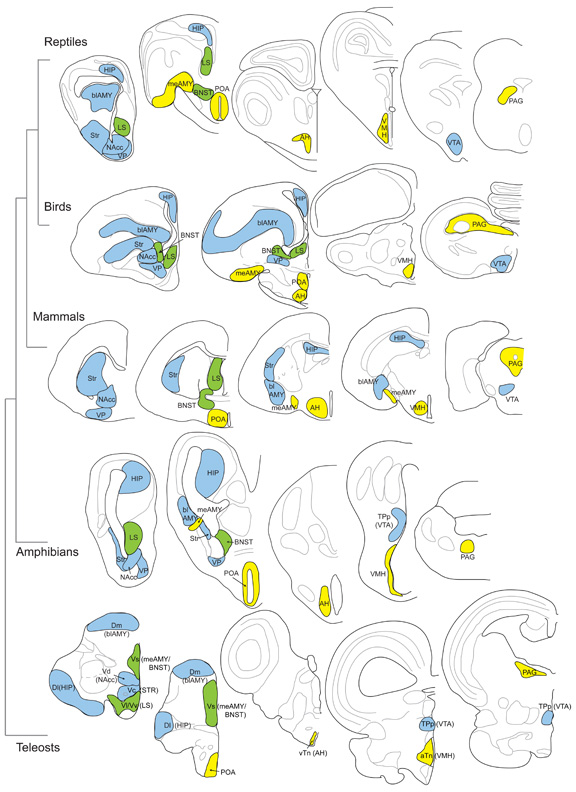Humans, fish and frogs share neural circuits responsible for a diversity of social behavior, from flashy mating displays to aggression and monogamy, that have existed for more than 450 million years.
 The location of two shared neural networks in brains of various vertebrates. The social behavior network (yellow) and mesolimbic reward system (blue) are two important neural networks regulating behavior in vertebrates and have functional connections (green) between the circuits. Illustration from O’Connell and Hofmann, “Evolution of a Vertebrate Social Decision-Making Network,” Science, June 2012. Copyright Science.
The location of two shared neural networks in brains of various vertebrates. The social behavior network (yellow) and mesolimbic reward system (blue) are two important neural networks regulating behavior in vertebrates and have functional connections (green) between the circuits. Illustration from O’Connell and Hofmann, “Evolution of a Vertebrate Social Decision-Making Network,” Science, June 2012. Copyright Science.
“There is an ancient circuitry that appears to be involved in social behavior across all vertebrates,” said Hans Hofmann, associate professor of integrative biology. “On a basic level, this tells us something about where we came from. A lot of the neural circuits that our brain uses for social behavior are actually quite old.”
Hofmann and graduate student Lauren O’Connell published their research in this week’s Science.
The biologists analyzed 12 regions of the brain responsible for social behavior and decision-making in 88 species of vertebrates including birds, mammals, reptiles, amphibians and fish.
They specifically looked at gene activity in two neural networks, one responsible for evaluating the relative importance of stimuli (the mesolimbic reward system), and one responsible for social behavior (the social behavior network). The former is important in drug addiction and romantic love, which manifests in the brain surprisingly like drug addiction.
“In these key brain regions, we found remarkable conservation of gene activity across species,” said Hofmann.
Despite the discovery of such consistency in gene activity, it’s easy to see that vertebrates have evolved a large diversity of behaviors during the past 450 million years.
That diversity can be partly explained, said Hofmann, as small variations on a theme. The basic neural circuits evolved long ago, providing a genetic and molecular framework for the evolution of new behavior. Small tweaks over time in those neural circuits then give rise to new behavior.
Monogamy, for example, has evolved multiple times independently in various vertebrate species. Monogamous behavior can be more advantageous for reproduction and survival under certain environmental conditions, and the research suggests that the evolution of this behavior is probably the result of small tweaks in a conserved neural network rather than evolving an entirely new one.
“Vertebrate brains are incredibly diverse, but we are finding the commonalities, even at the level of gene activity,” said Hofmann. “Now we have a framework with which we can ask whether there are molecular universals associated with social behaviors.”
Hofmann described “molecular universals” as common genes and molecules shared across species that form the bases of behavior, and he is on the hunt for them. This research highlights the areas of the vertebrate brain where he can now look for molecular universals in these shared neural circuits.

















Comments